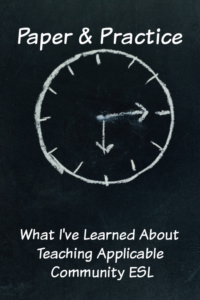 When I was teaching English in a Beijing high school, I wanted the students to play a common classroom game, either called Who Do You Love or Fruit Basket. Basically, every student with something in common (wearing sneakers, or with brown hair, or whatever) has to change places as fast as they can. But, in my class, my students all had black hair and school uniforms. And then the differences weren’t always things I wanted to draw extra attention to, like a boy who hadn’t had his growth spurt yet and I remember one girl had accidentally shaved off her eyebrow… Anyway, we made it work, and it became a fun classroom game, but it was a reminder of how different ESL teaching is on paper and in practice.
When I was teaching English in a Beijing high school, I wanted the students to play a common classroom game, either called Who Do You Love or Fruit Basket. Basically, every student with something in common (wearing sneakers, or with brown hair, or whatever) has to change places as fast as they can. But, in my class, my students all had black hair and school uniforms. And then the differences weren’t always things I wanted to draw extra attention to, like a boy who hadn’t had his growth spurt yet and I remember one girl had accidentally shaved off her eyebrow… Anyway, we made it work, and it became a fun classroom game, but it was a reminder of how different ESL teaching is on paper and in practice.
I’m now teaching a low-level ESL class in a community center. We’re doing daily routines and times, which is always a useful lesson. First, students work on times, with clocks and drawing hands and asking each other for the time. Then we do a little simple present, with pictures of daily activities. Students talk about themselves, and then ask a partner, and then tell the class about their partner. I’ve added a few extra activities to the usual list of take a shower and make breakfast to set students up for the next lessons on possessive adjectives, and because it’s funny to scream “No! YOU don’t check MY email every morning!” and “Are you sure he drives YOUR car to work every day?” when students tell me about their partner’s day.
This is always a nice, reliable activity for a low-level class, and describing one’s day is a solid second-language benchmark, but at the end, when individual students started to tell me about their partner’s days, everything completely fell apart. They were all talking about waking up at 11PM and eating breakfast at 3AM and leaving the house at 4 but not getting to work until 7. In this community center, our students don’t have a lot of first-language literacy, so I was convinced they didn’t understand the assignment, and they were just guessing at sentences using the vocab.
And then I finally realized, that, no, they all understood fine. My students actually have these schedules. Several of them work overnights. they weren’t confused about AM and PM, they were just telling me the facts. Some of them work a morning job and an night job. Students who first drop off their kids at a relative’s for daycare and then go to work by bus really do have hours from apartment to work.
They all knew what they were telling me, I was the confused one.
